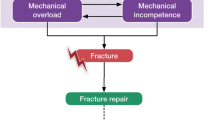Abstract
Of all fractures being linked with osteoporosis, those of the hip are the most important in terms of early death, functional dependence, and costs of care. Reduction of these adverse outcomes depends on preventing hip fractures caused by a fall on a biomechanically compromised proximal femur. In order to allow targeting of preventive care, there is considerable interest in predicting the risk of hip fracture. Bone densitometry is an established method to determine the risk of developing fractures. Recent studies, however, have identified additional factors which contribute to fracture risk independently of bone mass, suggesting that, in addition to taking measures that maintain bone density, risk factor modification may prove to be an effective strategy for preventing hip fracture. The aim of this article is to review current knowledge on clinical risk factors for hip fracture in elderly women.
Similar content being viewed by others
Author information
Authors and Affiliations
Additional information
Received: September 26, 2000; accepted: July 10, 2001
Rights and permissions
About this article
Cite this article
Haentjens, P., Vanderschueren, D., Broos, P. et al. Clinical Risk Factors for Osteoporotic Hip Fracture in Elderly Women – Implications for Fracture Prevention. Eur J Trauma 27, 163–170 (2001). https://doi.org/10.1007/s00068-001-1072-0
Issue Date:
DOI: https://doi.org/10.1007/s00068-001-1072-0




